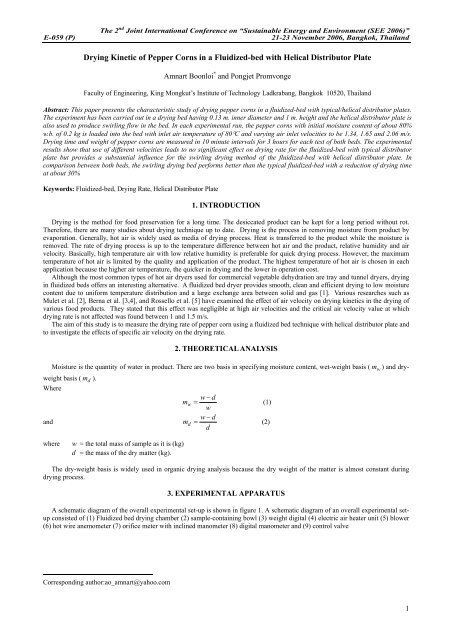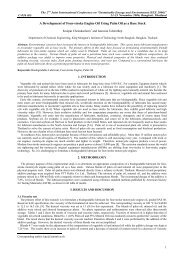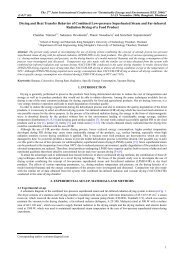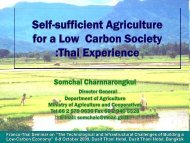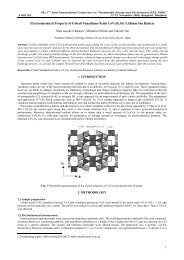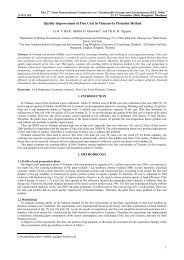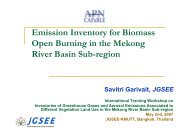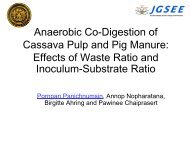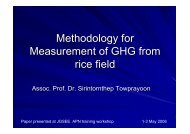Drying Kinetic of Pepper Corns in a Fluidized-bed with Helical ...
Drying Kinetic of Pepper Corns in a Fluidized-bed with Helical ...
Drying Kinetic of Pepper Corns in a Fluidized-bed with Helical ...
- No tags were found...
Create successful ePaper yourself
Turn your PDF publications into a flip-book with our unique Google optimized e-Paper software.
The 2 nd Jo<strong>in</strong>t International Conference on “Susta<strong>in</strong>able Energy and Environment (SEE 2006)”E-059 (P) 21-23 November 2006, Bangkok, Thailand<strong>Dry<strong>in</strong>g</strong> <strong>K<strong>in</strong>etic</strong> <strong>of</strong> <strong>Pepper</strong> <strong>Corns</strong> <strong>in</strong> a <strong>Fluidized</strong>-<strong>bed</strong> <strong>with</strong> <strong>Helical</strong> Distributor PlateAmnart Boonloi * and Pongjet PromvongeFaculty <strong>of</strong> Eng<strong>in</strong>eer<strong>in</strong>g, K<strong>in</strong>g Mongkut’s Institute <strong>of</strong> Technology Ladkrabang, Bangkok 10520, ThailandAbstract: This paper presents the characteristic study <strong>of</strong> dry<strong>in</strong>g pepper corns <strong>in</strong> a fluidized-<strong>bed</strong> <strong>with</strong> typical/helical distributor plates.The experiment has been carried out <strong>in</strong> a dry<strong>in</strong>g <strong>bed</strong> hav<strong>in</strong>g 0.13 m. <strong>in</strong>ner diameter and 1 m. height and the helical distributor plate isalso used to produce swirl<strong>in</strong>g flow <strong>in</strong> the <strong>bed</strong>. In each experimental run, the pepper corns <strong>with</strong> <strong>in</strong>itial moisture content <strong>of</strong> about 80%w.b. <strong>of</strong> 0.2 kg is loaded <strong>in</strong>to the <strong>bed</strong> <strong>with</strong> <strong>in</strong>let air temperature <strong>of</strong> 80°C and vary<strong>in</strong>g air <strong>in</strong>let velocities to be 1.34, 1.65 and 2.06 m/s.<strong>Dry<strong>in</strong>g</strong> time and weight <strong>of</strong> pepper corns are measured <strong>in</strong> 10 m<strong>in</strong>ute <strong>in</strong>tervals for 3 hours for each test <strong>of</strong> both <strong>bed</strong>s. The experimentalresults show that use <strong>of</strong> different velocities leads to no significant effect on dry<strong>in</strong>g rate for the fluidized-<strong>bed</strong> <strong>with</strong> typical distributorplate but provides a substantial <strong>in</strong>fluence for the swirl<strong>in</strong>g dry<strong>in</strong>g method <strong>of</strong> the fluidized-<strong>bed</strong> <strong>with</strong> helical distributor plate. Incomparison between both <strong>bed</strong>s, the swirl<strong>in</strong>g dry<strong>in</strong>g <strong>bed</strong> performs better than the typical fluidized-<strong>bed</strong> <strong>with</strong> a reduction <strong>of</strong> dry<strong>in</strong>g timeat about 30%Keywords: <strong>Fluidized</strong>-<strong>bed</strong>, <strong>Dry<strong>in</strong>g</strong> Rate, <strong>Helical</strong> Distributor Plate1. INTRODUCTION<strong>Dry<strong>in</strong>g</strong> is the method for food preservation for a long time. The desiccated product can be kept for a long period <strong>with</strong>out rot.Therefore, there are many studies about dry<strong>in</strong>g technique up to date. <strong>Dry<strong>in</strong>g</strong> is the process <strong>in</strong> remov<strong>in</strong>g moisture from product byevaporation. Generally, hot air is widely used as media <strong>of</strong> dry<strong>in</strong>g process. Heat is transferred to the product while the moisture isremoved. The rate <strong>of</strong> dry<strong>in</strong>g process is up to the temperature difference between hot air and the product, relative humidity and airvelocity. Basically, high temperature air <strong>with</strong> low relative humidity is preferable for quick dry<strong>in</strong>g process. However, the maximumtemperature <strong>of</strong> hot air is limited by the quality and application <strong>of</strong> the product. The highest temperature <strong>of</strong> hot air is chosen <strong>in</strong> eachapplication because the higher air temperature, the quicker <strong>in</strong> dry<strong>in</strong>g and the lower <strong>in</strong> operation cost.Although the most common types <strong>of</strong> hot air dryers used for commercial vegetable dehydration are tray and tunnel dryers, dry<strong>in</strong>g<strong>in</strong> fluidized <strong>bed</strong>s <strong>of</strong>fers an <strong>in</strong>terest<strong>in</strong>g alternative. A fluidized <strong>bed</strong> dryer provides smooth, clean and efficient dry<strong>in</strong>g to low moisturecontent due to uniform temperature distribution and a large exchange area between solid and gas [1]. Various researches such asMulet et al. [2], Berna et al. [3,4], and Rossello et al. [5] have exam<strong>in</strong>ed the effect <strong>of</strong> air velocity on dry<strong>in</strong>g k<strong>in</strong>etics <strong>in</strong> the dry<strong>in</strong>g <strong>of</strong>various food products. They stated that this effect was negligible at high air velocities and the critical air velocity value at whichdry<strong>in</strong>g rate is not affected was found between 1 and 1.5 m/s.The aim <strong>of</strong> this study is to measure the dry<strong>in</strong>g rate <strong>of</strong> pepper corn us<strong>in</strong>g a fluidized <strong>bed</strong> technique <strong>with</strong> helical distributor plate andto <strong>in</strong>vestigate the effects <strong>of</strong> specific air velocity on the dry<strong>in</strong>g rate.2. THEORETICAL ANALYSISMoisture is the quantity <strong>of</strong> water <strong>in</strong> product. There are two basis <strong>in</strong> specify<strong>in</strong>g moisture content, wet-weight basis ( m w ) and dryweightbasis ( m d ).Wherew − dm w =w(1)andw − dm d =d(2)wherew = the total mass <strong>of</strong> sample as it is (kg)d = the mass <strong>of</strong> the dry matter (kg).The dry-weight basis is widely used <strong>in</strong> organic dry<strong>in</strong>g analysis because the dry weight <strong>of</strong> the matter is almost constant dur<strong>in</strong>gdry<strong>in</strong>g process.3. EXPERIMENTAL APPARATUSA schematic diagram <strong>of</strong> the overall experimental set-up is shown <strong>in</strong> figure 1. A schematic diagram <strong>of</strong> an overall experimental setupconsisted <strong>of</strong> (1) <strong>Fluidized</strong> <strong>bed</strong> dry<strong>in</strong>g chamber (2) sample-conta<strong>in</strong><strong>in</strong>g bowl (3) weight digital (4) electric air heater unit (5) blower(6) hot wire anemometer (7) orifice meter <strong>with</strong> <strong>in</strong>cl<strong>in</strong>ed manometer (8) digital manometer and (9) control valveCorrespond<strong>in</strong>g author:ao_amnart@yahoo.com1
The 2 nd Jo<strong>in</strong>t International Conference on “Susta<strong>in</strong>able Energy and Environment (SEE 2006)”E-059 (P) 21-23 November 2006, Bangkok, ThailandFig. 1 Schematic diagram <strong>of</strong> experimental setup3.1 <strong>Fluidized</strong> <strong>bed</strong> dryerA diagram <strong>of</strong> the fluidized <strong>bed</strong> dryer, which was used <strong>in</strong> the experiment, is shown <strong>in</strong> Fig. 1. It possesses an acrylic plastic <strong>bed</strong>compartment <strong>of</strong> a circular section <strong>with</strong> the <strong>in</strong>ner diameter <strong>of</strong> 130 mm and the height <strong>of</strong> 1000 mm. Air distribution plate, fitted at thebottom, was a perforated plate <strong>with</strong> 908 holes, 3.2 millimeters <strong>in</strong> diameter <strong>of</strong> each hole, where the total hole area was 32 % <strong>of</strong> totalplate area. For fluidized <strong>bed</strong> dry<strong>in</strong>g, the most significant component is the dry<strong>in</strong>g column. Therefore, the thermal balance is derivedby apply<strong>in</strong>g mass and energy balances to the dry<strong>in</strong>g column <strong>in</strong> batch fluidization shown <strong>in</strong> Fig.2 (a). The dry<strong>in</strong>g process <strong>in</strong> a batchfluidized<strong>bed</strong> is modeled by assum<strong>in</strong>g a perfect mix<strong>in</strong>g <strong>of</strong> particles. The process occurs dur<strong>in</strong>g an isobaric process due tosimultaneous heat and mass transfer between hot air and corn.(a) fluidized-<strong>bed</strong> <strong>with</strong> typical distributor plate(b) fluidized-<strong>bed</strong> <strong>with</strong> helical distributor plateFig.2 Bed column <strong>with</strong> various dryers3.2 <strong>Fluidized</strong> <strong>bed</strong> <strong>with</strong> <strong>Helical</strong> Distributor PlateThe apparatus setup <strong>of</strong> fluidized <strong>bed</strong> <strong>with</strong> helical distributor plate was the same rig as the fluidized-<strong>bed</strong> dryer but the <strong>in</strong>let airdirection was different. In the case <strong>of</strong> dryer <strong>with</strong> helical distributor plate, the <strong>in</strong>let air was tangentially <strong>in</strong>jected <strong>in</strong>to the rig. Theschematic diagram <strong>of</strong> fluidized <strong>bed</strong> <strong>with</strong> helical distributor plate as can be seen <strong>in</strong> Fig. 2(b). The swirl<strong>in</strong>g flow was generated by ahelical distributor placed at the bottom <strong>of</strong> the rig. Therefore, the air was spiraled upward as swirl<strong>in</strong>g flow. The helical plate provided2
The 2 nd Jo<strong>in</strong>t International Conference on “Susta<strong>in</strong>able Energy and Environment (SEE 2006)”E-059 (P) 21-23 November 2006, Bangkok, Thailanda flow direction <strong>with</strong> 30˚ <strong>in</strong>cl<strong>in</strong>ation from the horizontal plane as can be seen <strong>in</strong> Fig. 3. The superficial air velocity <strong>in</strong> the <strong>bed</strong> is set to1.34, 1.65 and 2.06 m/s for all experiments.Fig.3 Characteristic <strong>of</strong> helical distributor plate3.3 Corn gra<strong>in</strong>In the experiment, the pepper corns were dry<strong>in</strong>g media. The pepper corns ware loaded <strong>in</strong>to the test section at 0.2 kilograms each<strong>with</strong> 80% humidity (wet basis)3.4 Procedure<strong>Dry<strong>in</strong>g</strong> time and weight <strong>of</strong> pepper corns are measured <strong>in</strong> 10 m<strong>in</strong>ute <strong>in</strong>tervals for 3 hours for each test <strong>of</strong> both techniques. A 3-hpblower coupled to an <strong>in</strong>verter for controll<strong>in</strong>g the airflow rate was used to supply air which is preheated <strong>with</strong> a 7.5 kW electric heater<strong>in</strong>serted at the plenum chamber. The electric heater provided hot air <strong>of</strong> a maximum temperature <strong>of</strong> 120 o C and the heat<strong>in</strong>g took about15 m<strong>in</strong>utes for the <strong>bed</strong> to raise its temperature until 80 o C. In experiments, the temperature <strong>of</strong> the <strong>bed</strong> was measured by means <strong>of</strong>type-K thermocouples. The measurement <strong>of</strong> fluidiz<strong>in</strong>g airflow rate was taken us<strong>in</strong>g an orifice meter and the m<strong>in</strong>imum fluidizationvelocity was measured <strong>in</strong> the usual way as the po<strong>in</strong>t <strong>of</strong> <strong>in</strong>teraction between two straight l<strong>in</strong>es on a plot <strong>of</strong> velocity at the <strong>in</strong>letdistributor plates and pressure drop across the <strong>bed</strong>4. RESULTS AND DISCUSSIONIn the experimental results, the effect <strong>of</strong> the superficial air velocity on dry<strong>in</strong>g rate is <strong>in</strong>vestigated us<strong>in</strong>g various dry<strong>in</strong>g techniquesas can be seen <strong>in</strong> Figs. 4-6. In the first part <strong>of</strong> the study, experiments were performed to compare the dry<strong>in</strong>g rates <strong>of</strong> variedsuperficial air velocity (<strong>in</strong>let air temperature <strong>of</strong> 80°C). In the second part <strong>of</strong> the study, experiments were performed to determ<strong>in</strong>e theeffects <strong>of</strong> <strong>in</strong>let air velocity (1.34, 1.65, 2.06 m/s). F<strong>in</strong>ally, the third part <strong>of</strong> the study was devoted to the study <strong>of</strong> the effects <strong>of</strong> variousdry<strong>in</strong>g techniques (fluidized <strong>bed</strong> <strong>with</strong>/<strong>with</strong>out helical distributor plates)4.1 Effect <strong>of</strong> superficial air velocity on dry<strong>in</strong>g rate<strong>Dry<strong>in</strong>g</strong> rate for the fluidized-<strong>bed</strong> <strong>with</strong> air <strong>in</strong>let velocities <strong>of</strong> 1.34, 1.65 and 2.06 m/s is presented for the <strong>bed</strong> <strong>with</strong> a typicaldistributor as seen <strong>in</strong> Fig.4. It is found that the moisture content <strong>of</strong> pepper corns is highly reduced for a dry<strong>in</strong>g time period <strong>of</strong> 0 - 100m<strong>in</strong>. and then gradually decreases for the rest <strong>of</strong> dry<strong>in</strong>g times for all velocities. The decreases <strong>in</strong> the moisture content <strong>with</strong> dry<strong>in</strong>g timeare nearly the same for all velocities especially at higher velocity. This <strong>in</strong>dicates that the reduction <strong>of</strong> the moisture content <strong>of</strong> peppercorns would not be effected by air velocity used. Fig. 5 shows the variations <strong>of</strong> the moisture content <strong>of</strong> pepper corns <strong>with</strong> dry<strong>in</strong>g timefor the fluidized-<strong>bed</strong> <strong>with</strong> a helical plate. In the figure, the moisture content <strong>of</strong> pepper corns is decreased rapidly <strong>with</strong> dry<strong>in</strong>g time forthe first half <strong>of</strong> dry<strong>in</strong>g and the dry<strong>in</strong>g rate is high at the beg<strong>in</strong>n<strong>in</strong>g <strong>of</strong> dry<strong>in</strong>g and then tends to reduce slightly for the second half <strong>of</strong>dry<strong>in</strong>g. The moisture content reduces <strong>with</strong> the rise <strong>of</strong> the dry<strong>in</strong>g air velocity. This po<strong>in</strong>ts out that the dry<strong>in</strong>g air velocity has asignificant effect on the dry<strong>in</strong>g <strong>of</strong> pepper corns, especially at higher air <strong>in</strong>let velocity. The dry<strong>in</strong>g rate <strong>of</strong> the swirl<strong>in</strong>g technique isfound to be better than the typical fluidized <strong>bed</strong> technique.100Moisture Content (%)806040201.34 m/s1.65 m/s2.06 m/s00 20 40 60 80 100 120 140 160 180 200<strong>Dry<strong>in</strong>g</strong> Time (m<strong>in</strong>)Fig. 4 Variation <strong>of</strong> moisture content <strong>of</strong> pepper corns <strong>with</strong> dry<strong>in</strong>g time for us<strong>in</strong>g typical distributor plate3
The 2 nd Jo<strong>in</strong>t International Conference on “Susta<strong>in</strong>able Energy and Environment (SEE 2006)”E-059 (P) 21-23 November 2006, Bangkok, Thailand100Moisture Content (%)806040201.34 m/s1.65 m/s2.06 m/s00 20 40 60 80 100 120 140 160 180 200<strong>Dry<strong>in</strong>g</strong> Time (m<strong>in</strong>)Fig. 5 Variation <strong>of</strong> moisture content <strong>of</strong> pepper corns <strong>with</strong> dry<strong>in</strong>g time for us<strong>in</strong>g helical distributor plate4.2 Comparison between fluidized <strong>bed</strong> techniques <strong>with</strong> typical/helical distributor platesFig.6 showed a plot at a particular air flow rate for both the techniques. The results show that the dry<strong>in</strong>g time is obviously different forus<strong>in</strong>g air <strong>in</strong>let velocity at 2.06 m/s for both techniques. The dry<strong>in</strong>g rate <strong>of</strong> the fluidized <strong>bed</strong> <strong>with</strong> the helical distributor plate is better thanfluidized <strong>bed</strong> <strong>with</strong> typical distributor plate.10080Typical Distributor Plate<strong>Helical</strong> Distributor PlateMoisture Content (%)60402000 20 40 60 80 100 120 140 160 180 200<strong>Dry<strong>in</strong>g</strong> Time (m<strong>in</strong>)Fig. 6 Comparison between dry<strong>in</strong>g pepper corns <strong>in</strong> the typical <strong>bed</strong> and the <strong>bed</strong> <strong>with</strong> helical plate at air velocity <strong>of</strong> 2.06 m/s.5. CONCLUSIONSExperimental study <strong>of</strong> moisture content reduction <strong>of</strong> dry<strong>in</strong>g pepper corns is carried out <strong>in</strong> a fluidized-<strong>bed</strong> <strong>with</strong> a helical distributorplate. The experimental results show that the use <strong>of</strong> different velocities leads to no significant effect on dry<strong>in</strong>g rate for the fluidized<strong>bed</strong><strong>with</strong> typical distributor plate but provides substantial <strong>in</strong>fluence for the swirl<strong>in</strong>g dry<strong>in</strong>g method <strong>of</strong> fluidized-<strong>bed</strong> <strong>with</strong> helicaldistributor plate. The swirl<strong>in</strong>g dry<strong>in</strong>g <strong>bed</strong> performs better than the typical fluidized-<strong>bed</strong> which can reduce dry<strong>in</strong>g time at some 30%.6. REFERENCES[1] M.S. Nargal and B. Oraikul, Effect <strong>of</strong> some physical and chemical pre-treatment on improvement <strong>of</strong> dry<strong>in</strong>g characteristics <strong>of</strong>hash-brown potatoes, J Food Science Technology, 33, 436-439 (1996).[2] A. Mulet et al., Effect <strong>of</strong> air flow rate on carrot dry<strong>in</strong>g’, <strong>Dry<strong>in</strong>g</strong> Technology, 5, 25-258 (1987).[3] A. Berna et al., <strong>Dry<strong>in</strong>g</strong> k<strong>in</strong>etics <strong>of</strong> apricots’ In: Spiess WEL, Schubert H: editors. Eng<strong>in</strong>eer<strong>in</strong>g and food, Physical properties andprocess control, London: Elsevier Applied Science, 1, 628-636 (1990).[4] A Berna et al., <strong>Dry<strong>in</strong>g</strong> k<strong>in</strong>etics <strong>of</strong> Majorcan seedless grape variety, In: Mulumdar AS, editor, <strong>Dry<strong>in</strong>g</strong>’91, Amsterdam: ElsevierScience Publishers, 455-462 (1991).[5] A. Rossello et al., Simple mathematical model to predict the dry<strong>in</strong>g rates <strong>of</strong> potatoes, J Agric Food Chemical, 40, 2374-2378(1992).4


